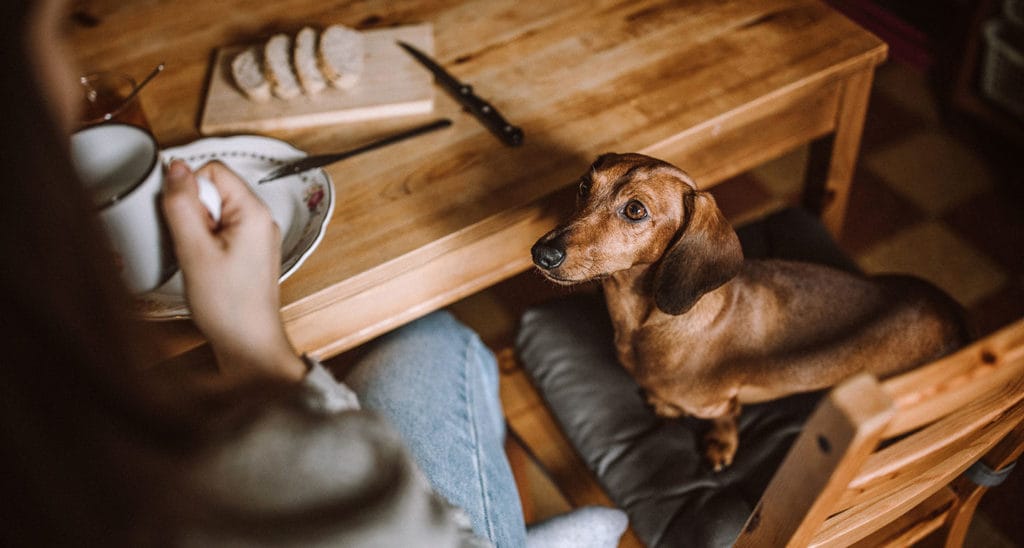The holiday season is synonymous with feasts, family and fun. Including your pets in your holiday traditions is a great way to make sure everyone is full of holiday cheer. There are plenty of holiday activities you and your pets can do together, but when it comes to the holiday feast, keep it reserved for humans only.
We know that the holiday spirit brings out everyone’s charitable side, but sharing your meals with your pets can reinforce undesirable dog behaviors. We talked with Paula Nowak, CPDT-KA, CTDI, the head trainer and behavior consultant for Canine Country Academy in Lawrenceville, Georgia, about training dogs to not beg. Here are some tips for setting your pups up for success when it comes to time spent around the dinner table.
Nowak says that the best way to stop dog begging is to never let your dog practice the behavior to begin with. So if you just adopted a new dog or got a new puppy, you should start training them as soon as possible. During training, Nowak recommends, “At the dining table and/or counter, avoid rewarding your dog for actively begging.” Remember that rewards aren’t just food rewards. “Telling our dog to ‘Get down,’ or ‘Leave-it,’ can be seen as reinforcement since they are getting attention.”
Using Management
Nowak says that management is a great tool to prevent dog begging. You can use a dog gate, like the Carlson Pet Products Extra Wide Walk-Thru Gate with Pet Door, to keep your pet out of the kitchen and your dining areas. The key is to restrict their access to the food prep and eating areas so that they are not tempted to beg or jump up and steal food from counters and tables. If a gate doesn’t make sense in your house, then you can always use one of the many dog crates like the Frisco Fold & Carry Double Door Dog Crate.
While nobody wants their pet to feel left out during dinnertime, proper mealtime behavior is a very important skill for your dog. Not only in the home, but when you take your pup out to eat with you, it is important they are not a begging dog. To keep them occupied during mealtime, you can always give them a KONG Classic Dog Toy filled with peanut butter or their favorite wet food as a treat.
If your pooch is already a begging all-star, it will require some commitment and consistency to train them to reflect proper dog behaviors. As Nowak explains, “Dogs who are fed at the table are not all beggars! If you reward the dog while they are actively begging, then you are teaching them to beg. If you reward them when they are not begging, or are learning to lie at your feet without pestering you, then we are reinforcing the appropriate behavior.”
The “Place” Command
One option for training dogs not to beg is teaching them the “Place” command. What this means is teaching your dog to sit or lie on a specific rug or dog bed while you are cooking or eating.
- Place the bed or rug in the desired location, which should be a few feet or more away from where you are eating or cooking. Nowak explains, “The distance will help add clarity as to where the dog should remain in order to be rewarded for staying on their ‘Place.’”
- Lure your dog with a treat onto the dog bed or rug. Once they have all four paws on the bed or rug, reward them. Nowak adds, “You can also add criteria by asking for a ‘Sit’ or ‘Down’ on the target location and then reward them. We want our dog to know that staying on their ‘Place’ equals room service, since you will bring dog treats to them.”
- If they get up, do not scold—just reset and repeat the command. They are learning a new skill, so give them some time to figure it out.
- If they can stay in place after one step backward, then try to add another step. It is similar to the “Stay” command, in that we want to reward them for staying in place as we continually back away.
- In addition to working on distance, you will also need to practice duration. You want them to stay in place not just when you are across the room, but to be able to hold their place while you are cooking. So increase the time intervals between treats as they hold their place.
Tip: Nowak advises, “If your dog needs help staying in place, you can tether a leash to a strong piece of furniture. You will still want to deliver treats periodically so they know they are doing the correct behavior.” - Once your dog is 80% reliable at staying on their rug or bed, you can start to pair the cue word “Place” with the action. As Nowak explains, “This way you can send them there when you start to prepare a meal. To teach the cue word, say ‘Place,’ or your desired word, while pointing to the bed or rug (stay within a foot of the location). Wait for them to get on the ‘place’ and reward. It will take many repetitions for them to pair the word with the known behavior.”
While dog begging is an undesirable dog behavior, it can also be unsafe for your dog. There are a host of dangerous foods for dogs on our dinner tables during the holiday season. To keep our pets as safe as possible, it is always best to let them stick to their dog-approved foods and to avoid feeding them table scraps. Emergency veterinary clinics are always inundated with cases where a dog has gotten a hold of foods toxic to dogs—and those vet visits do not come cheap—so it is always best to err on the side of caution and let your pup stick to their doggie kibbles.
If you really want to include your dog in holiday feasts, you can always get your dog one of Merrick’s fun holiday-themed cans of dog food, like the Venison Holiday Stew or the Thanksgiving Day Dinner, which are both dog-friendly and sure to please.

Kendall Curley, BeChewy Editorial Assistant
As a former Connecticut resident, Kendall is coming to terms with the lack of seasons in Florida by gaining an appreciation for all the activities that the Florida climate allows year-round. When she is not hard at work at Chewy, she can be found going on adventures with her dog, Pip, or going horseback riding with her friends. She is an avid fosterer of dogs and spends an inordinate amount of time picking dog hair off of her clothes and belongings.
Share:
















